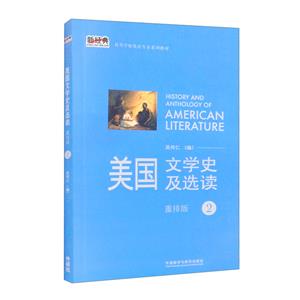-
>
中医基础理论
-
>
高校军事课教程
-
>
毛泽东思想和中国特色社会主义理论体系概论(2021年版)
-
>
中医内科学·全国中医药行业高等教育“十四五”规划教材
-
>
中医诊断学--新世纪第五版
-
>
中药学·全国中医药行业高等教育“十四五”规划教材
-
>
中医外科学——全国中医药行业高等教育“十四五”规划教材
美国文学史及选读(2)(新经典高等学校英语专业系列教材)(2021版) 版权信息
- ISBN:9787513531696
- 条形码:9787513531696 ; 978-7-5135-3169-6
- 装帧:一般胶版纸
- 册数:暂无
- 重量:暂无
- 所属分类:>>
美国文学史及选读(2)(新经典高等学校英语专业系列教材)(2021版) 本书特色
适读人群 :学生,教师,一般读者《美国文学史及选读》是吴伟仁教授编写的一套"史"、"选"结合的文学教材,内容经典,自出版以来,重印四十余次,畅销不衰。本书共两册,涵盖了殖民地时期至20世纪的美国文学发展史及重要作家作品,既可作为高等学校英语专业文学课教材,也可供广大美国文学爱好者使用。
美国文学史及选读(2)(新经典高等学校英语专业系列教材)(2021版) 内容简介
《美国文学史及选读》共两册,根据美国文学历史的顺序结合作品选读编写而成,是一套"史"、"选"结合的教材。在历史部分,对美国文学史的每个阶段作了简明扼要的概述,而在作品选读部分则尽可能遴选了文学目前的重要作家和重要作品。教材内容丰富,语言地道优美,选文具有代表性,可作高校英语专业文学课程的课本或参考书,也是广大英美文学爱好者的理想读物。本书是第二册,内容涵盖现实主义时期至20世纪的美国文学。
美国文学史及选读(2)(新经典高等学校英语专业系列教材)(2021版) 目录
美国文学史及选读(2)(新经典高等学校英语专业系列教材)(2021版) 节选
By the end ofthe Civil War (1861-1865) most ofthe forces that would typify twentieth-century America had begun to emerge. Northern industrialism had triumphed over Southern agrarianism, and from that victory came a society based on mass labor and mass consumption. Mechanization spread rapidly as steam engines, linked to machines, displaced hand work on farms and in factories. The conditions oflabor changed, for the new machines, with their great cost and efficiency, seemed far more valuable and more useful than the workers who tended them. Yet increasing numbers of Americans left the farms to seek jobs in urban factories. In the cities, swollen with growing numbers of the poor and the unskilled, angry forces were stirring that would profoundly alter the nation'spolitics and its social ideals. Traditional political alliances had begun to shift as the lower classes sought greater power at the poils. The great age of big-city bossism began, and the art of political patronage and graft rose to new heights throughout the land. During the Civil War the powers of the federal government rapidly expanded. The first conscription laws were passed, the first federal income taxes were levied, and a national currency, controlled by the federal government, was issued. In 1865 the first step toward racial equality was made when the Thirteenth Amendment to the Constitution was adopted, abolishing slavery within the United States. Business growth and exploitation of natural resources created new wealth, concentrating vast riches and economic power in the hands of a few. It was the beginning of what Mark Twain called "The Gilded Age," an age of excess and extremes, of decline and progress, of poverty and dazzling wealth, of gloom and buoyant hope.In the first decades after the Civil War, Americans ceased to be isolated from the world and from each other. Telegraph lines spanned the nation,and in 1866 a trans-Atlantic cable joined America and Europe. The first transcontinental railroad was completed in 1869, linking the Atlantic and the Pacific. Soon the United States had the most extensive railroad system in the world, which in turn generated enormous commercial expansion. The cost of transporting raw materials and finished goods dropped. Products once made locally by costly handwork were replaced by inexpensive goods. The tempo oflife accelerated as Americans became increasingly mobile,Journeys of weeks or months were reduced to a few days. In the last surge of westward expansion, Americans, lured by the promise of free land, settled the last of the first forty-eight states, By 1890 the frontier, the westward-moving line of settlement begun three hundred years before on the Atlantic Coast,ceased to exist. Yet its influence would long remain, shaping the life of the nation and inspiring the legends, novels, and western movies by which the world would come to know America. The period between the end of the Civil War and the beginning of World War I was a time of steel and steam, electriaty and oil. Steel production in the United States increased more than six hundred times, and steelmaking became the nation's dominant industry. Alternating electrical current was introduced in 1886. Incandescent lamps illuminated the cities with electricity provided by giant, steam-driven dynamos. The tallow candles and whale-oil lamps of rural America were replaced by lanterns filled with kerosene made from crude oil. The American petroleum industry began, and with it came the age of the automobile. From 1870 to 1890 the total population of the United States doubled.Villages became towns, towns became cities, and cities grew to a size and with a speed that would have astonished the Founding Fathers. From 1860 to 1910 the population of Philadelphia tripled, that of New York City more than quadrupled, while the population of Chicago increased twenty times to two million, making it the nation's second largest city.
美国文学史及选读(2)(新经典高等学校英语专业系列教材)(2021版) 作者简介
吴伟仁,汉族,1913年10月生于河北邯郸。河北师范大学外国语学院(原外语系)英语教授、全国高等学校外国文学教学研究会理事。长期从事英语语言文学教学和科研工作。主要论著有《意象派和美国现代诗歌》等。
- >
诗经-先民的歌唱
诗经-先民的歌唱
¥15.1¥39.8 - >
经典常谈
经典常谈
¥22.7¥39.8 - >
巴金-再思录
巴金-再思录
¥33.1¥46.0 - >
月亮虎
月亮虎
¥15.4¥48.0 - >
【精装绘本】画给孩子的中国神话
【精装绘本】画给孩子的中国神话
¥17.6¥55.0 - >
姑妈的宝刀
姑妈的宝刀
¥11.4¥30.0 - >
企鹅口袋书系列·伟大的思想20:论自然选择(英汉双语)
企鹅口袋书系列·伟大的思想20:论自然选择(英汉双语)
¥6.9¥14.0 - >
龙榆生:词曲概论/大家小书
龙榆生:词曲概论/大家小书
¥9.1¥24.0
-
那时 书妆-百花小开本散文书衣
¥29.3¥38 -
设计学概论-(全新版)
¥20.6¥48 -
习近平关于全面从严治党论述摘编
¥13.2¥24 -
数据结构(C++语言版)(第3版)本科教材
¥41.3¥59 -
学前儿童家庭与社区教育
¥21¥30 -
2022图书×抽奖盲袋
¥9.9¥25















